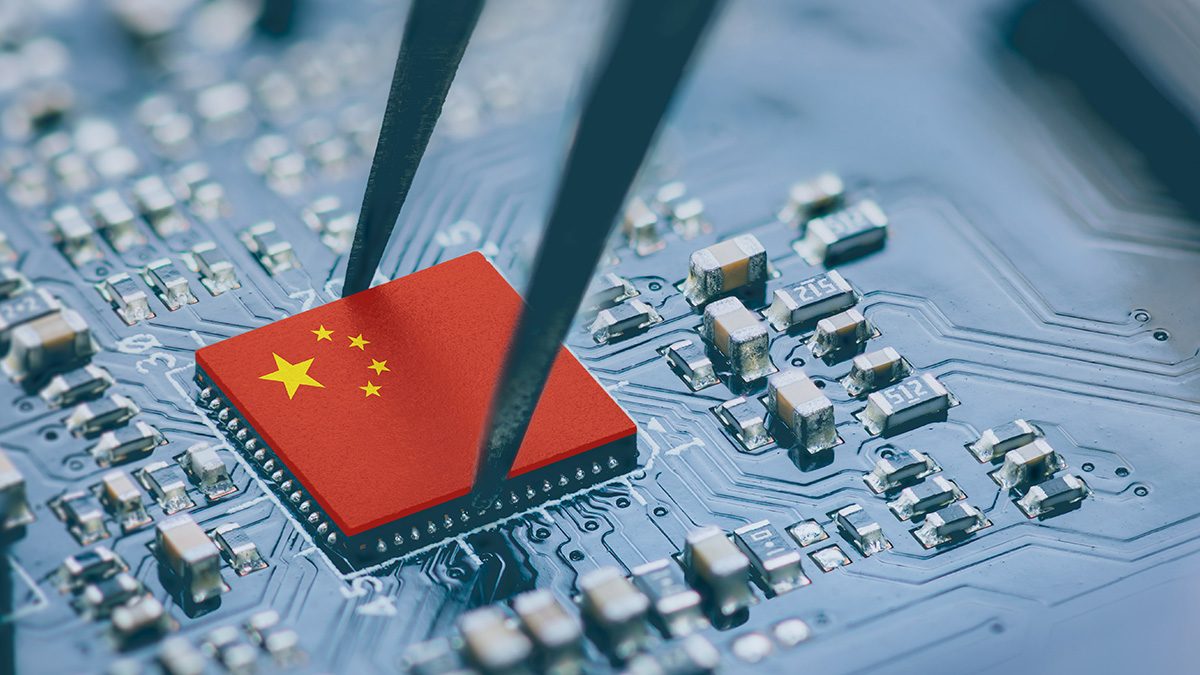Key points
- DeepSeek’s advancements represent continued innovation in the artificial intelligence (AI) theme and reinforce prospects for lower pricing.
- We expect model competition to remain intense.
- Lower pricing should support new application development; likewise, we believe that innovative software and internet companies may lead the next wave of growth in the theme.
- Longer term, enterprises that embrace AI first may have an edge in differentiating their products and services and may outperform their competitors.
China-based startup DeepSeek took the markets by storm recently, igniting a broad sell-off in US technology stocks with the launch of DeepSeek-R1, the most recent iteration of its generative artificial-intelligence (AI) model. The R1 model has quickly risen in popularity, propelling to the top of the US Apple App Store’s free applications, where it surpassed competitors like OpenAI’s ChatGPT.
DeepSeek has attracted significant attention for its cost-effective and innovative AI approach. This has prompted swirling concerns that the Chinese AI company was able to achieve its efficiencies and high-performance results using less advanced hardware, potentially circumventing US export controls on high-end AI chips.
DeepSeek’s success challenges the prevailing notion that larger models and more computational resources are essential for AI advancement. Ultimately, if DeepSeek’s claims are true and large language models (LLMs) can be trained with fewer AI chips at a fraction of the cost of competitors’ models, there are a myriad of investment implications to consider. Investors fear this could reduce demand for advanced AI chips, as well as for large-scale data centres and extensive power production to support models. While we believe that lower development costs could pose challenges for hardware and semiconductor companies in the medium term, we see greater development and growth opportunities for hyperscalers, software companies and AI consumers beyond the technology sector.
The geopolitical race for innovation
DeepSeek’s AI chatbot was released as an open-source model, meaning its source code is publicly available, so users can customise and distribute it as they see fit, subject to the open-source license. The Chinese startup claims to have trained the chatbot for under $6 million, substantially less than US tech giants have spent on similar models. DeepSeek also claims that it used far fewer and lower-grade chips than its American competitors, thereby building a product that rivals counterparts despite US efforts to restrict exports of semiconductor manufacturing equipment to China.
The DeepSeek story highlights the massive geopolitical race at play for AI dominance and the intensifying competition between the West and China. Should global markets be worried about China’s next big move? China has seemingly demonstrated that when companies release groundbreaking LLMs, it can produce cheaper, albeit slightly less performant, versions. If powerful AI models can be built without the most advanced hardware, high-end chip producers could take a hit.
In our view, we should be prepared for disruption on both the supply side and demand side, and not just from China. For instance, OpenAI has since unveiled new innovations that demonstrate fresh capabilities in driving leading-edge research efforts. Based on past technology cycles, recent news coverage highlights how the theme should continue to evolve at a rapid rate. Investors should anticipate that these advancements may usher in lower prices that could spark the elasticity required to drive new applications and the next wave of growth.
In our view, we should be prepared for disruption on both the supply side and demand side, and not just from China.
Intense competition for model development
While DeepSeek’s ultimate cost structure remains in question, we expect the competitive environment for models to remain intense. We believe this competition should foster lower pricing and drive elasticity, creating new markets that support further long-term growth in the theme.
Despite the prospects for lower cost models and rapid price declines, earnings results continue to highlight rising capital expenditures (capex) from hyperscalers in 2025. We continue to see rapid innovation and expect more companies to move workloads into the cloud to leverage these advancements.
But what does this ultimately mean for data-centre capex, and especially for the energy complex? Based on a comprehensive data-centre tracker built by our research associates, we believe capital spending intentions in the near time are robust, if not improving; several hyperscalers boosted capex in their recent earnings announcements. Some of that rise in capital spending is reportedly for investments in long-lived assets, including land and buildings in new regions, and therefore not indicative of an overbuild in compute capacity. Also, as AI matures, more countries are developing sovereign AI strategies that require new data centres in regions where considerable up-front infrastructure investment boosts capital spending on an interim basis.
A myriad of investment implications
Hyperscalers and software
Based on comments made by two influential US tech companies, we believe it is safe to assume that DeepSeek realised at least some cost advantage in building its model. If this is accurate and the cost of building models drops substantially, we believe that hyperscalers and software companies are likely to benefit.
Lower capital intensity equates to higher returns, and we generally think this dynamic bodes well for hyperscalers. Hence, our view on hyperscalers continues to be positive, though we favour those that are less focused on being vertically integrated. Hyperscalers are driven by compounding growth in data and applications, and we believe lower capital costs support that growth algorithm. Additionally, US hyperscalers could become security gatekeepers, which may reinforce the moat of these large companies as geopolitical forces potentially further ration AI technology between the West and the East.
We also believe these developments may boost certain software companies. We have a positive outlook on infrastructure software providers that deliver tools and applications used in developing AI products. Our view is also favourable on application software and internet companies that may embed AI into their products and services. Edge computing companies may also benefit as lower cost and faster inferencing at the edge becomes more compelling.
Late last year, prior to DeepSeek’s recent announcement, our research analysts had expressed their bullish take on consumption software, owing to improved comparables and a desire to bet on more AI application development in 2025. Additionally, during research visits in December, our analysts gathered evidence that more companies believed that their AI products were ready to ship. Assuming that DeepSeek’s claims are true, the Jevon’s paradox argument—which suggests that increased efficiency can lead to increased demand—crystalises our positive view of software in 2025; if hardware costs are coming down to train LLMs and to ship them and for the increased adoption of AI products, there should be more AI products shipping in 2025 and 2026.
Hardware and semiconductors
On hardware and semiconductors, we are a bit more guarded as we believe the risk to both sectors has increased over the medium term.
On the hardware front, we have uncertainty around whether a significant reduction in compute costs would lead to a proportional increase in demand on a shorter-term basis. Lower capital intensity may yield excess compute capacity for a period of time before demand elasticity kicks in.
Beyond technology
AI is a foundational technology capable of reshaping various industries and the economy over time. AI technology has expansive potential beyond traditional chatbots. Tech giants and others are exploring broader AI applications, including autonomous vehicles, robotics and digital twins. We believe that many of the biggest winners from the AI theme are likely to be the companies that apply it in non-technology industries, e.g., in manufacturing, health care and financials. These companies are likely to use declining costs of AI innovation to pull those applications in to propel revenue growth.
Longer term, AI-driven labour automation and the cost advantage for companies adopting AI pose risks to jobs in certain industries, including sales, marketing and administrative functions. In our view, companies that have higher costs in those areas relative to their peers may disproportionately benefit from the adoption of AI, unfortunately at the expense of workers.
We harness our multidimensional research capabilities to help us identify potential winners within and beyond the tech ecosystem, while understanding broader investment implications.
Regulatory and geopolitical policy changes
We are monitoring the regulatory and geopolitical environment for potential policy moves that may shift competitive advantages and prompt changes to fundamentals.
For instance, the construction of data centres in the European Union is driven by stringent regulations aimed at protecting European consumer data. Despite potential shifts in AI models, the core need for secure data storage remains unchanged. This regulatory environment necessitates a proactive approach to monitor and adapt to new policies, ensuring that businesses can navigate these changes effectively.
In US regulatory developments, President Trump issued an executive order in January aiming to reduce regulations and accelerate progress in AI. Trump’s order rescinded former President Biden’s 2023 executive order that sought to tighten regulations on advanced computer chips, potentially restricting shipments of AI chips to certain countries beyond US allies. While we expect the political and regulatory environment to remain dynamic, we expect AI companies to remain under increased scrutiny regarding their compliance with export restrictions and operational transparency.
Cyber risks are also a key consideration, as downloading AI applications can introduce new avenues for cyber attacks. Social risks, including trust and misinformation, are also heightened in this context. As regulatory developments continue to unfold, it is crucial for investors to stay informed and prepared for the evolving challenges and opportunities.
The ever-evolving AI industry
At Newton, we utilise our global multidimensional research capabilities to stay abreast of the latest technology innovations, in China and elsewhere. In the case of DeepSeek, our fundamental research analysts have been assessing the credibility of headlines and the potential impact of news on hardware, software, power generation and power infrastructure investments. Our quantitative team has identified 21 past instances since 1990 when top constituents of the S&P 500 were down 15% or more in one day; they have been examining those instances to assess what the past might reveal about future market performance. Members of our specialist team have consulted with a former director for China economics on the White House National Security Council; they have reviewed media interviews by the hedge fund sponsoring DeepSeek to evaluate the credibility of the claims and assess the geopolitical implications.
DeepSeek’s latest innovation highlights the dynamic and rapidly evolving nature of AI technology. The competitive landscape is intensifying, and as companies continue to innovate and adapt, the potential for lower costs and increased efficiency could drive new applications and growth opportunities across various industries. Investors should remain vigilant and prepared for the ongoing changes likely to shape the future of AI and its impact on the global market.
This is a financial promotion. These opinions should not be construed as investment or other advice and are subject to change. This material is for information purposes only. This material is for professional investors only. Any reference to a specific security, country or sector should not be construed as a recommendation to buy or sell investments in those securities, countries or sectors. Please note that holdings and positioning are subject to change without notice. This article was written by members of the NIMNA investment team. ‘Newton’ and/or ‘Newton Investment Management’ is a corporate brand which refers to the following group of affiliated companies: Newton Investment Management Limited (NIM), Newton Investment Management North America LLC (NIMNA) and Newton Investment Management Japan Limited (NIMJ). NIMNA was established in 2021 and NIMJ was established in March 2023. MAR007108 Exp 02/30.
Important information
Issued by Newton Investment Management Ltd. ‘Newton’ and/or ‘Newton Investment Management’ is a corporate brand which refers to the following group of affiliated companies: Newton Investment Management Limited (NIM), Newton Investment Management North America LLC (NIMNA) and Newton Investment Management Japan Limited (NIMJ). NIMNA was established in 2021 and NIMJ was established in March 2023. In the United Kingdom, NIM is authorised and regulated by the Financial Conduct Authority (‘FCA’), 12 Endeavour Square, London, E20 1JN, in the conduct of investment business. Registered in England no. 01371973. Registered office: 160 Queen Victoria Street, London, EC4V 4LA, UK. NIM and NIMNA are both registered as investment advisors with the Securities & Exchange Commission (‘SEC’) to offer investment advisory services in the United States. NIM’s investment business in the United States is described in Form ADV, Part 1 and 2, which can be obtained from the SEC.gov website or obtained upon request. NIMJ is authorised and regulated by the Japan Financial Services Agency (JFSA). All firms are indirect subsidiaries of The Bank of New York Mellon Corporation (‘BNY’).







Comments